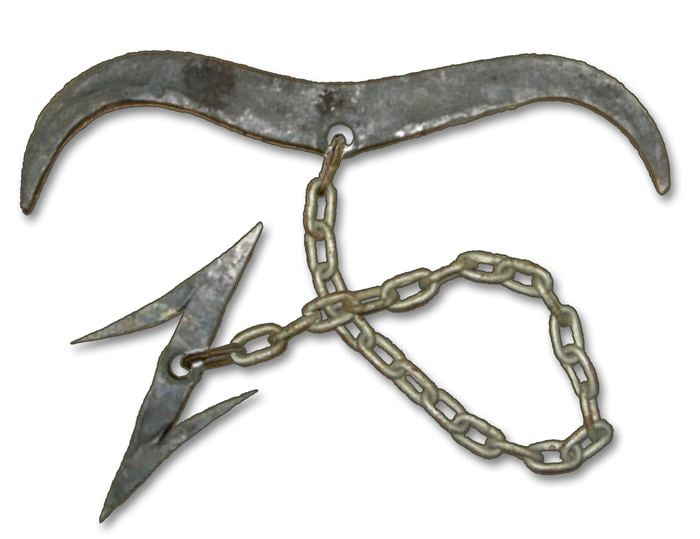 | ||
The Wolfsangel ( [ˈvɔlfsˌʔaŋəl]) is a German heraldic charge inspired by an actual historic wolf trap consisting of two metal parts and a connecting chain. The top part of the trap, which resembled a crescent moon with a ring inside, used to be fastened between branches of a tree in the forest while the bottom part, on which meat scraps used to be hung, was a hook meant to be swallowed by a wolf. The simplified design based on the iron "wolf-hook" was often heavily stylized to no longer resemble a baited hook hung from a tree or an entire wolf trap. Other names included Wolfsanker ("wolf-anchor") or Wolfsjagd as well as hameçon or hameçon de loup, a half-moon shape with a ring, or as cramp or crampon in English with a ring at the center, sometimes also called Doppelhaken ("double-hook"), or acrampon with a transversal stroke. All of these symbols are still found in a number of municipal coats of arms in Germany. The crampon is also found as a mason's mark in medieval stonework.
Contents
In early times, believed to possess magical powers, it became a symbol of liberty and independence after its adoption as an emblem of a peasant revolt in the 15th century against the oppression of the German princes and their mercenaries.
The Wolfsangel was an initial symbol of the Nazi Party. In World War II the sign and its elements were used by various Nazi German storm divisions such as the Waffen-SS Division Das Reich and the Waffen-SS Division Landstorm Nederland. In pre-war Germany, the Wolfsangel was partly inspired by the immense popularity of Hermann Löns's 1910 novel Der Wehrwolf during the 1930s, where the protagonist, a resistance fighter during the Thirty Years' War, adopted the magic symbol as his personal badge. The symbol itself bears a visual resemblance to the Eihwaz rune, historically part of the runic alphabet.
Heraldry
The name Wolfsangel appears in a 1714 heraldic handbook, Wappenkunst, associated with a symbol distinct from the one now known under this name.
- Wolffs-Angel, frantz. hamecon, lat. uncus quo lupi capiuntur, ist die Form eines halben Mondes und hat inwendig in der Mitte einen Ring.
- "Wolffs-Angel, French hamecon, Latin uncus quo lupi capiuntur ("hook with which wolves are caught"), is the shape of a crescent moon with a ring inside, at mid-height"
The above quote, although, written for the Wolfsangel is referring to the Anchor (see below) for the Wolfsangel and not the Wolfsangel or "Wolf's-hook" proper.
In modern German-language heraldic terminology, the name Wolfsangel is de facto used for a variety of heraldic charges, including
The crampon symbol is found comparatively frequently in municipal coats of arms in Germany, where it is often identified as "Wolfsangel". The "crampon with central stroke" design is more rare, but is still found in about a dozen contemporary municipal coats of arms. The French town of Wolfisheim, in the Alsace region of France has a "Wolfsangel" in its coat of arms.
As boundary marker and "forestry symbol"
In a 1616 boundary treaty concluded between Hesse and Brunswick-Lüneburg, the Brunswick boundary marker was called Wulffsangel. It was used not only on landmarks, but there is also evidence of its use in correspondence from the Forest Services in 1674.
Later the Wolfsangel was also used as a symbol on forest uniforms. In a document of 1792 regarding new uniforms, chief forester Adolf Friedrich von Stralenheim suggested a design for uniform buttons including the letters "GR" and a symbol similar to the Wolfsangel, which he called Forstzeichen. Later the Wolfsangel was also worn as a single badge in brass caps on the service and on the buttons of the Hanoverian forest supervisor. In Brunswick it was prescribed for private forest and gamekeepers also as badge on the bonnet.
The Wolfsangel is still used the various forest districts in Lower Saxony as a boundary marker, and it is part of the emblem of the state of Lower Saxony and the hunters' association Hirschmann, dedicated to the breeding and training of Hanover Hounds.
In literature
In 1910, Hermann Löns published a classic fiction book entitled Der Wehrwolf (later published as Harm Wulf, a peasant chronicle and The Warwolf in English) set in a 17th-century German farming community during the Thirty Years' War. The main character of the book, Harm Wulf, adopts the Wolfsangel as a badge against the occupying forces of the ruling princes. Some printings of this book, such as the 1940 edition, showcase a very visible Wolfsangel on the book cover. It also features on Löns' gravestone.
As a Nazi symbol
In Nazi Germany, the Wolfsangel was used by:
Post-WWII
Public exhibition of the symbol is illegal in Germany if a connection with one of these groups is apparent. After World War II, the symbol was used by some Neo-Nazi organizations. In United States extremist white supremacist Aryan Nations organization uses white Wolfsangel symbol with a sword replacing the cross-bar in its logo.
A similar sign was used in Ukraine by SNPU, Social-National Assembly. and Azov Battalion. Group members claim that the symbol is an abbreviation for the slogan "Ідея Нації" (ukr. for "National Idea") and deny connection with Nazism.
Also it is used by the Church of Satan in horizontal form.
